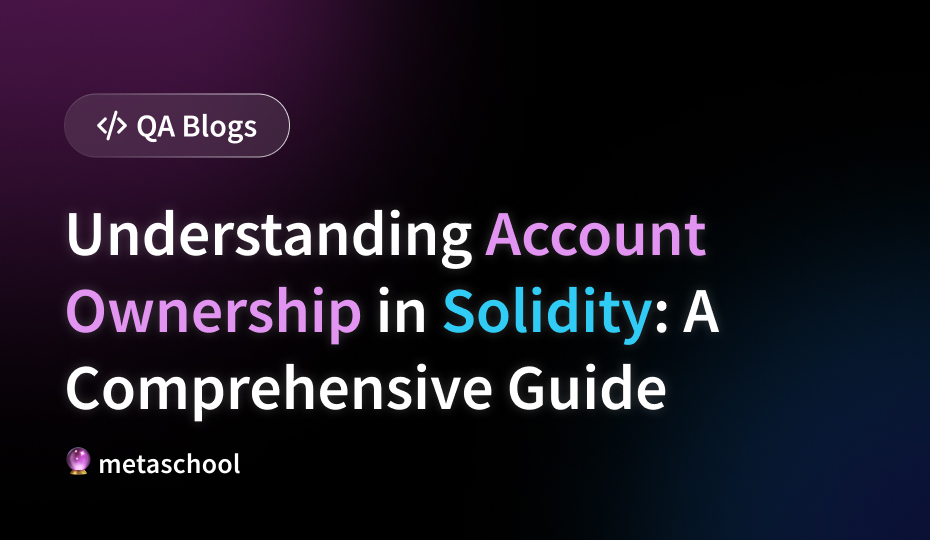Table of Contents
In the realm of Ethereum smart contracts, understanding account ownership is akin to mastering the foundation upon which secure and robust decentralized applications (DApps) are built. In this guide, we will delve into the nuances of account ownership in Solidity, elucidating concepts through clear explanations and practical coding examples.
The Basics: public and private keys
In Solidity, cryptographic keys form the bedrock of account ownership. These keys come in pairs:
- Private Key: This is akin to a secret password granting access to your Ethereum account. Safeguarding your private key is paramount, as possession of it confers control over your assets.
- Public Key: Derived from the private key through cryptographic algorithms, the public key acts as an identifier for your account. It’s freely shareable and serves as the entry point for transactions and interactions.
Ethereum addresses
Ethereum addresses are derived from public keys through a series of cryptographic operations. An Ethereum address is a 20-byte value represented in hexadecimal format. It’s what you share with others to receive payments or interact with contracts on the Ethereum blockchain.
An Ethereum address looks like this: 0x4bbeEB066eD09B7AEd07bF39EEe0460DFa261520.
🔥 Check this course out: Build a One Piece Personality dApp With Solidity
Ownership and control
When we talk about ownership in Solidity, it’s essential to understand the distinction between ownership and control.
- Ownership: Ownership of an Ethereum account is determined by whoever holds the private key associated with that account. It’s akin to holding the deed to a property.
- Control: Control, on the other hand, refers to the ability to execute transactions or interact with contracts using that account. While ownership implies control, the reverse isn’t necessarily true. You may own an account but delegate control to a smart contract.
Smart contracts and account ownership
Smart contracts, autonomous agents executing predefined logic, play a pivotal role in the Ethereum ecosystem. Understanding their relationship with account ownership is paramount:
// SPDX-License-Identifier: MIT
pragma solidity ^0.8.0;
contract MyContract {
address public owner;
constructor() {
owner = msg.sender;
}
function doSomething() public {
require(msg.sender == owner, "Only the owner can perform this action");
// Execute action
}
}
- External Ownership: Smart contracts interact with external accounts, facilitating transactions and function calls. In the provided example,
ownerrepresents the external account controlling the contract. - Internal Ownership: Smart contracts themselves can own assets or funds. The contract’s logic dictates how these assets are managed or distributed.
🔥 Check this course out: Create Your Own Ethereum Token in Just 30 Mins
Transferring ownership in solidity smart contracts
In Solidity, transferring ownership of a contract is a common requirement, especially in scenarios where administrative control needs to be passed from one entity to another. Let’s explore how to implement ownership transfer functionality within a smart contract, along with detailed explanations.
// SPDX-License-Identifier: MIT
pragma solidity ^0.8.0;
contract Ownable {
address public owner;
constructor() {
owner = msg.sender;
}
modifier onlyOwner() {
require(msg.sender == owner, "Only the owner can perform this action");
_;
}
function transferOwnership(address newOwner) public onlyOwner {
require(newOwner != address(0), "Invalid address");
owner = newOwner;
}
}Explanation:
ownerVariable: This public variable stores the address of the current owner of the contract.- Constructor: The constructor sets the
ownervariable to the address of the deployer of the contract, effectively initializing ownership. onlyOwnerModifier: This modifier ensures that only the current owner can execute certain functions by requiring that the sender of the transaction matches theowneraddress.transferOwnershipFunction: This function allows the current owner to transfer ownership to a new address. It takes the new owner’s address as an argument.- Validity Check: It ensures that the new owner’s address is not zero, indicating a valid address.
- Ownership Transfer: If the conditions are met, the
ownervariable is updated with the address of the new owner, effectively transferring ownership.
Example Usage
contract MyContract is Ownable {
string public data;
function setData(string memory _data) public onlyOwner {
data = _data;
}
}
contract ExampleUsage {
MyContract public myContract;
constructor() {
myContract = new MyContract();
}
function changeOwnership(address newOwner) public {
myContract.transferOwnership(newOwner);
}
}Explanation:
MyContractDefinition: This contract inherits from theOwnablecontract, thus gaining ownership-related functionality.setDataFunction: An example function restricted to the contract’s owner. It allows setting a string valuedata.ExampleUsageContract: This contract demonstrates the usage of thetransferOwnershipfunction from an external contract.changeOwnershipFunction: This function can be called by anyone. It invokes thetransferOwnershipfunction ofMyContract, effectively transferring ownership to the specified address.
Security considerations
Security is paramount in Solidity development. Considerations include:
- Secure Key Management: Employ robust key management practices to safeguard private keys.
- Immutable Contracts: Once deployed, contracts are immutable. Extensive testing and auditing are necessary to identify and mitigate vulnerabilities.
- Access Control: Implement strict access control mechanisms to prevent unauthorized actions and ensure the integrity of the contract’s functionalities.
🔥 Check this course out: Write an Elon Musk NFT Smart Contract on OpenSea
Conclusion
In conclusion, mastering account ownership in Solidity is pivotal for developing secure and reliable smart contracts on the Ethereum blockchain. Through a solid grasp of cryptographic keys, Ethereum addresses, ownership patterns, and security best practices, developers can navigate the complexities of decentralized applications with confidence and precision. By incorporating coding examples and adhering to established principles, we pave the way for a more secure and decentralized future.
Try it out, ask us questions, and tell us how it went by tagging Metaschool on Social Media.
Follow us on –
🔮Twitter – https://twitter.com/0xmetaschool
🔗LinkedIn – https://www.linkedin.com/company/0xmetaschool/
